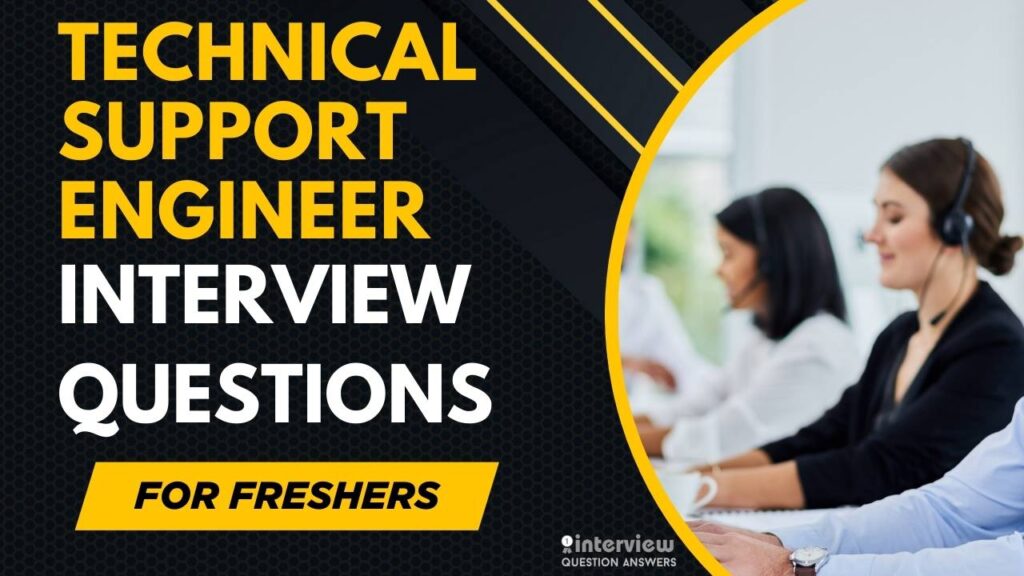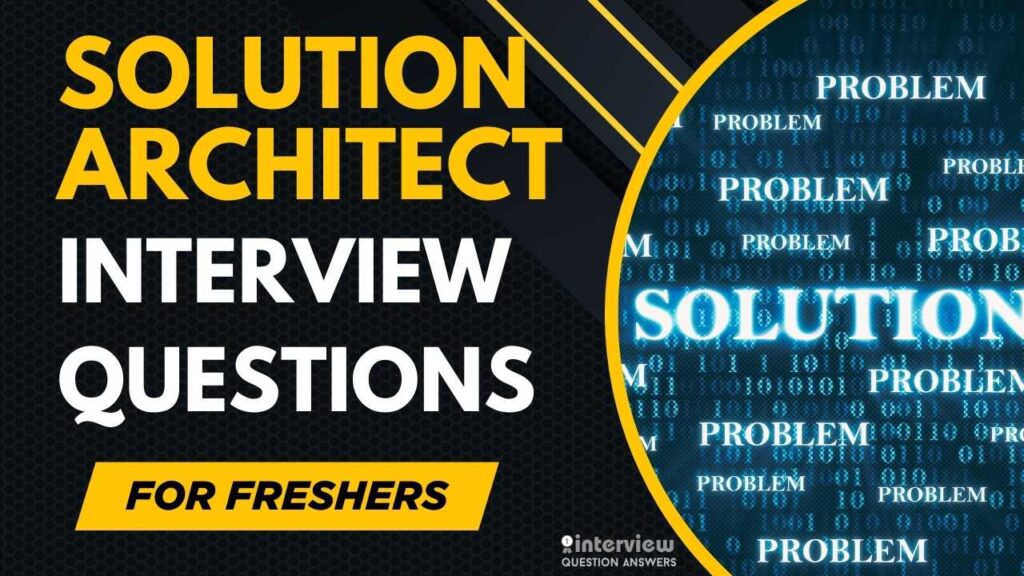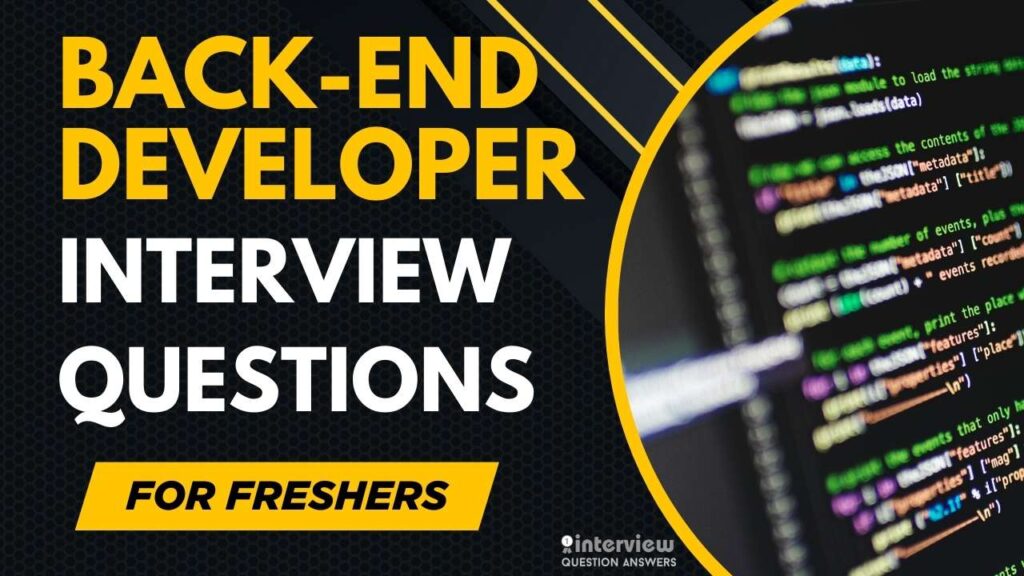Solution Architect plays a key role in designing technical systems and software solutions that solve real-world business problems. Whether working with cloud platforms like AWS, Azure, or GCP, or developing enterprise-level applications using Java, Python, C#, or other technologies, Solution Architects focus on creating secure, scalable, and cost-efficient solutions.
On this page, we have shared a comprehensive set of questions for both freshers and experienced professionals, including specialized sections for AWS Solution Architects, Azure Solution Architects, and technology-specific roles like Java, Python, and C# Solution Architects.
We’ve also included scenario-based questions, real-world challenges, and architectural design considerations, helping candidates prepare beyond theoretical knowledge. Additionally, a PDF is shared below for easy offline access, so you can prepare anytime, anywhere.
Table of Contents
Top Solution Architect Interview Questions and Answers
Let’s start with some of the most asked Solution Architect interview questions with their sample answers, but remember, you have to prepare your own answers based on your knowledge and experience.
Que 1. What is the primary role of a Solution Architect?
Answer:
A Solution Architect designs the overall technical structure of a system or application to solve business problems. They choose technologies, define architecture patterns, and ensure that all components work together effectively and securely to meet client needs.
Que 2. What are the key skills required for a Solution Architect?
Answer:
- Strong understanding of cloud platforms (AWS, Azure, GCP)
- Expertise in system design and architecture patterns
- Knowledge of databases, APIs, and networking
- Good communication and leadership skills
- Experience with security, scalability, and cost optimization strategies
Que 3. How do Solution Architects differ from Technical Architects?
Answer:
Solution Architects focus on the overall system design aligned to business needs, covering both software and infrastructure. Technical Architects focus more deeply on the implementation and technical details of specific areas, like software frameworks or databases.
Que 4. Explain Microservices Architecture.
Answer:
Microservices architecture breaks down an application into smaller, independent services that communicate over APIs. Each service handles a specific business function, making the system more scalable, maintainable, and resilient compared to monolithic architectures.
Que 5. What are common cloud deployment models?
Answer:
- Public Cloud: Services delivered over the public internet (AWS, Azure).
- Private Cloud: Dedicated infrastructure for a single organization.
- Hybrid Cloud: Combination of public and private clouds for flexibility.
- Multi-Cloud: Using services from multiple cloud providers simultaneously.
Que 6. How do you handle scalability in solution architecture?
Answer:
- Use load balancers to distribute traffic
- Implement horizontal scaling for stateless components
- Use managed services like auto-scaling groups
- Optimize databases using read replicas and sharding
- Use caching layers to reduce load on backend systems
Que 7. What is the importance of High Availability (HA) in architecture?
Answer:
High Availability ensures that a system stays operational with minimal downtime, even during failures. This involves using redundant resources, failover mechanisms, health checks, and deploying across multiple availability zones or regions.
Que 8. What steps would you take to secure a cloud-based architecture?
Answer:
- Use Identity and Access Management (IAM)
- Enable encryption for data at rest and in transit
- Implement firewall and security groups
- Use secure API gateways
- Regularly audit logs and monitor system activity
Que 9. What are key considerations for migrating a legacy system to the cloud?
Answer:
- Assess current architecture and dependencies
- Choose a suitable migration strategy (Rehost, Refactor, Rebuild)
- Plan for data migration and downtime
- Address compliance and security requirements
- Optimize costs after migration
Que 10. What is Infrastructure as Code (IaC)?
Answer:
Infrastructure as Code allows managing and provisioning infrastructure using code instead of manual processes. Tools like Terraform and AWS CloudFormation help automate deployments, maintain consistency, and support version control of infrastructure configurations.
Que 11. How do Solution Architects manage technical debt?
Answer:
- Regularly review and refactor legacy components
- Prioritize high-impact technical issues
- Communicate risks and trade-offs to stakeholders
- Incorporate debt reduction tasks into project roadmaps
- Promote adherence to architecture standards and best practices
Que 12. What is a Design Pattern, and why is it important?
Answer:
Design Patterns are proven solutions to common design problems. They help Solution Architects create scalable and maintainable architectures by using standardized approaches like Singleton, Factory, or Observer patterns to solve recurring challenges.
Que 13. How do you approach cost optimization in cloud architecture?
Answer:
- Use pay-as-you-go resources
- Select right-sized instances
- Implement auto-scaling to avoid idle resources
- Use spot instances for non-critical workloads
- Monitor and analyze usage using cloud billing tools
Que 14. What is the difference between Vertical and Horizontal Scaling?
Answer:
| Scaling Type | Description |
|---|---|
| Vertical Scaling | Adding more power (CPU/RAM) to a single machine |
| Horizontal Scaling | Adding more machines to handle increased load |
Horizontal scaling is generally preferred for better fault tolerance and flexibility.
Que 15. What challenges do Solution Architects often face?
Answer:
- Balancing business needs with technical feasibility
- Handling tight deadlines and budget constraints
- Managing system complexity and legacy integrations
- Ensuring security without sacrificing performance
- Communicating solutions clearly to both technical teams and business stakeholders
Que 16. How do you design a fault-tolerant architecture for a cloud-based application?
Answer:
Design fault tolerance by leveraging redundancy across Availability Zones, using load balancers (e.g., AWS ELB), and implementing auto-scaling groups. Incorporate circuit breakers (e.g., with Resilience4j) and retry mechanisms for service failures. Monitor with tools like AWS CloudWatch or Azure Monitor to detect and recover from failures, ensuring minimal downtime.
Que 17. What is the role of API Gateway in a microservices architecture?
Answer:
API Gateway acts as a single entry point for client requests, routing them to appropriate microservices. It handles authentication (e.g., OAuth), rate limiting, and request transformation, reducing complexity and enhancing security. Examples include AWS API Gateway and Azure API Management.
Que 18. How do you ensure data consistency in a distributed system?
Answer:
Use eventual consistency for high availability or strong consistency for critical transactions. Implement patterns like Saga for distributed transactions, use message queues (e.g., RabbitMQ, Kafka) for asynchronous updates, and leverage database replication with conflict resolution strategies.
Que 19. What considerations do you make when choosing between SQL and NoSQL databases?
Answer:
Evaluate data structure, scalability, and query needs. Choose SQL (e.g., PostgreSQL) for structured data and complex joins; NoSQL (e.g., MongoDB) for unstructured data, high write throughput, or horizontal scaling. Consider latency, cost, and team expertise for the final decision.
Que 20. How do you approach designing a hybrid cloud architecture?
Answer:
Integrate on-premises infrastructure with cloud services using VPN or direct connections (e.g., AWS Direct Connect, Azure ExpressRoute). Ensure consistent security policies, use container orchestration (e.g., Kubernetes) for portability, and implement data sync mechanisms to balance cost and performance.
Also Check: Solution Architect Interview Questions for Freshers
Que 21. What is the CAP theorem, and how does it impact your architecture decisions?
Answer:
The CAP theorem states a distributed system can only guarantee two of Consistency, Availability, and Partition Tolerance. Choose Consistency and Availability for critical systems (e.g., banking) or Availability and Partition Tolerance for high-traffic apps (e.g., e-commerce), tailoring database and service choices accordingly.
Que 22. How do you implement observability in a solution architecture?
Answer:
Implement observability with logging (e.g., ELK Stack), metrics (e.g., Prometheus), and tracing (e.g., Jaeger). Centralize logs in tools like AWS CloudWatch, set up dashboards for real-time monitoring, and use distributed tracing to diagnose latency in microservices.
Que 23. How do you design a serverless architecture for a high-traffic application?
Answer:
Use serverless components like AWS Lambda or Azure Functions for compute, paired with managed services (e.g., DynamoDB, Cosmos DB) for storage. Implement API Gateway for routing, enable auto-scaling, and optimize cold starts with provisioned concurrency to handle high traffic.
Que 24. What is the role of Domain-Driven Design (DDD) in solution architecture?
Answer:
DDD aligns architecture with business domains, modeling bounded contexts and aggregates. Define clear domain boundaries, use microservices or modules to encapsulate logic, and ensure collaboration with domain experts to reflect business needs in the system design.
Que 25. How do you handle disaster recovery planning in your architecture?
Answer:
Design a disaster recovery plan with RTO and RPO goals, using multi-region deployments and backups (e.g., AWS RDS snapshots). Implement automated failover with tools like AWS Route 53 or Azure Traffic Manager, and test recovery procedures regularly to ensure reliability.
Que 26. How do you evaluate and select a cloud provider for a new project?
Answer:
Assess providers based on cost, service offerings (e.g., AI, compute), compliance (e.g., GDPR), and regional availability. Compare SLAs, scalability options, and ecosystem integrations (e.g., AWS SageMaker vs. Azure ML), conducting POCs to validate performance and fit.
Que 27. What is event-driven architecture, and how do you implement it?
Answer:
Event-driven architecture uses events to trigger actions across loosely coupled services. Implement with message brokers like Kafka or AWS SNS/SQS, defining event schemas and consumers. Ensure idempotency and fault tolerance for reliable event processing.
Que 28. How do you ensure low-latency performance in a global application?
Answer:
Use CDNs (e.g., CloudFront, Azure CDN) for static content, deploy services in multiple regions, and optimize database queries with indexing or caching (e.g., Redis). Implement latency-based routing and monitor performance with tools like New Relic for continuous improvement.
Que 29. How do you design a CI/CD pipeline for a microservices-based architecture?
Answer:
Use tools like Jenkins or GitHub Actions to create pipelines with automated builds, tests, and deployments. Implement service-specific pipelines, use containerization (e.g., Docker), and integrate with Kubernetes for orchestration, ensuring zero-downtime deployments with blue-green strategies.
Que 30. How do you approach designing a secure API architecture?
Answer:
Secure APIs with authentication (OAuth 2.0, JWT), encryption (TLS), and rate limiting. Use API Gateway for access control, implement input validation, and monitor with tools like AWS WAF or Azure Application Gateway to protect against threats like SQL injection or DDoS.
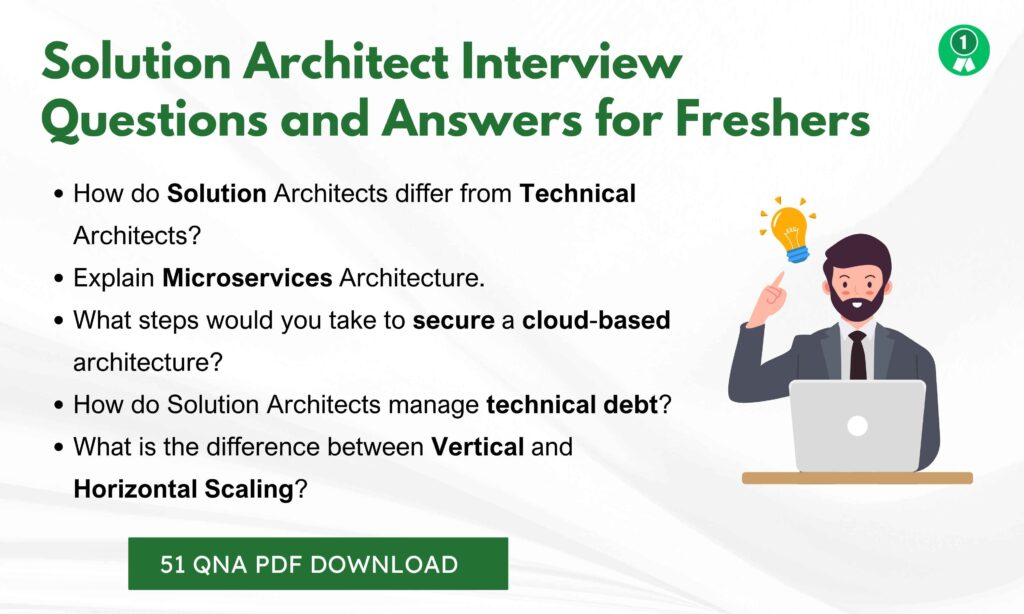
Also Check: Data Engineer Interview Questions and Answers
AWS Solution Architect Interview Questions and Answers
Que 31. What are the core responsibilities of an AWS Solution Architect?
Answer:
An AWS Solution Architect designs cloud solutions using AWS services. Responsibilities include choosing appropriate AWS services, designing secure architectures, optimizing costs, ensuring scalability, and helping development teams implement best practices for cloud deployments.
Que 32. How does Amazon S3 ensure data durability?
Answer:
Amazon S3 ensures 99.999999999% (11 9’s) durability by automatically storing multiple copies of data across different availability zones. It uses versioning, replication, and regular data integrity checks to prevent data loss.
Que 33. What are AWS Availability Zones and Regions?
Answer:
- Region: A geographic area containing multiple Availability Zones.
- Availability Zone (AZ): A data center or group of data centers within a region.
Using multiple AZs allows high availability, fault tolerance, and disaster recovery.
Que 34. What is the difference between EC2 and Lambda?
Answer:
- Amazon EC2: Provides virtual servers with full OS control for hosting applications.
- AWS Lambda: Serverless compute service that runs code without provisioning servers, billed based on execution time.
Que 35. How do you secure AWS API Gateway endpoints?
Answer:
- Use AWS IAM for internal APIs.
- Use Cognito User Pools for authentication.
- Implement API Keys and Usage Plans.
- Use Lambda authorizers for custom token validation.
Que 36. What is AWS Auto Scaling and how does it work?
Answer:
AWS Auto Scaling automatically adjusts the number of EC2 instances based on demand using scaling policies. It ensures consistent performance and optimizes costs by scaling resources up or down.
Que 37. How does Amazon CloudFront improve performance?
Answer:
Amazon CloudFront is a CDN that caches content at edge locations globally. This reduces latency by serving content closer to users, improving load times for static and dynamic content.
Que 38. How do you monitor AWS resources effectively?
Answer:
Use AWS CloudWatch to monitor resource usage, create custom metrics, and set up alarms. Use AWS Config to track resource configurations and CloudTrail for auditing API calls across AWS infrastructure.
Que 39. How do you design a cost-effective architecture on AWS for a startup with fluctuating traffic?
Answer:
Use AWS Auto Scaling with EC2 instances or ECS for compute, paired with Spot Instances for non-critical workloads. Store static assets in S3 with CloudFront for low-cost delivery. Implement Lambda for serverless tasks, monitor costs with AWS Budgets, and use Reserved Instances or Savings Plans for predictable workloads to optimize expenses.
Que 40. What is AWS Elastic Beanstalk, and when should you use it?
Answer:
AWS Elastic Beanstalk is a PaaS for deploying and managing applications without handling underlying infrastructure. Use it for simple web apps or APIs requiring quick setup, automatic scaling, and load balancing, ideal for teams with limited DevOps expertise.
Que 41. How do you secure an S3 bucket to prevent unauthorized access?
Answer:
Enable bucket policies to restrict access, use IAM roles for authenticated users, and enforce encryption (SSE-S3 or KMS). Disable public access, implement versioning, and monitor with CloudTrail to track access attempts, ensuring compliance with security best practices.
Que 42. How does AWS RDS Multi-AZ deployment enhance database reliability?
Answer:
AWS RDS Multi-AZ creates a standby replica in a different Availability Zone, enabling automatic failover in case of primary instance failure. It ensures high availability for relational databases (e.g., MySQL, PostgreSQL) with minimal downtime, ideal for critical applications.
Que 43. How do you implement a serverless data pipeline on AWS?
Answer:
Use AWS Lambda for processing, S3 for storage, and AWS Glue for ETL tasks. Trigger Lambda with S3 events or EventBridge schedules, store processed data in DynamoDB or Redshift, and monitor with CloudWatch for a scalable, low-maintenance pipeline.
Que 44. What is AWS Step Functions, and how do you use it in workflows?
Answer:
AWS Step Functions orchestrates serverless workflows by coordinating Lambda functions, ECS tasks, or other services. Define state machines in JSON (ASL), handle error retries, and monitor execution with CloudWatch, ideal for complex, multi-step processes like order processing.
Que 45. How do you optimize query performance in Amazon Redshift?
Answer:
Optimize Redshift by choosing appropriate distribution and sort keys, compressing data, and using workload management (WLM) to prioritize queries. Vacuum and analyze tables regularly, leverage materialized views, and monitor with Query Performance Insights for efficiency.
Que 46. How do you implement a disaster recovery strategy using AWS services?
Answer:
Design with RTO/RPO goals, using multi-region S3 replication and RDS cross-region replicas. Implement Route 53 for failover routing, automate backups with AWS Backup, and test recovery with Chaos Engineering tools to ensure resilience.
Que 47. What is AWS VPC Peering, and when should you use it?
Answer:
VPC Peering connects two VPCs to enable private communication using AWS’s backbone. Use it for resource sharing across VPCs (e.g., EC2 to RDS in different accounts), ensuring low-latency, secure data transfer without public internet exposure.
Que 48. How do you use AWS CloudFormation for infrastructure management?
Answer:
AWS CloudFormation automates infrastructure provisioning using JSON/YAML templates. Define resources (e.g., EC2, S3), deploy stacks, and manage updates or rollbacks. Use it for repeatable, version-controlled infrastructure setups across environments.
Que 49. How do you monitor and troubleshoot performance issues in an AWS-based application?
Answer:
Use CloudWatch for metrics and logs, X-Ray for tracing requests, and Trusted Advisor for optimization recommendations. Set up alarms for thresholds (e.g., CPU usage), analyze slow queries, and use AWS Systems Manager for automated remediation.
Que 50. How do you design a secure microservices architecture on AWS?
Answer:
Deploy microservices in ECS or EKS with private subnets in a VPC. Use API Gateway with IAM roles or Cognito for authentication, encrypt data with KMS, and monitor with WAF and CloudTrail to protect against threats and ensure compliance.
Azure Solution Architect Interview Questions and Answers
Que 51. What are the key responsibilities of an Azure Solution Architect?
Answer:
An Azure Solution Architect designs cloud solutions using Microsoft Azure services. Responsibilities include selecting the right Azure resources, ensuring security, scalability, cost management, and guiding development teams in implementing cloud-based architectures aligned with business goals.
Que 52. What is Azure Resource Manager (ARM)?
Answer:
Azure Resource Manager is the deployment and management service for Azure resources. It allows managing infrastructure using declarative ARM templates, supports role-based access control (RBAC), and ensures consistent resource deployments across environments.
Que 53. How does Azure ensure High Availability in its services?
Answer:
Azure achieves High Availability using Availability Sets, Availability Zones, and paired regions. Services like Azure Load Balancer and Traffic Manager distribute traffic, while geo-redundant storage (GRS) ensures data is replicated across regions for fault tolerance.
Que 54. What is Azure Virtual Network (VNet)?
Answer:
Azure Virtual Network is a secure, isolated network within Azure where resources like VMs and databases can securely communicate. VNets support subnets, IP addressing, routing, peering, and integration with on-premises networks using VPN or ExpressRoute.
Que 55. What is Azure Functions and when should it be used?
Answer:
Azure Functions is a serverless compute service that lets you run small pieces of code without managing servers. It’s ideal for event-driven applications like data processing, API backends, or automation tasks, with billing based on execution time.
Que 56. How do you secure applications in Azure?
Answer:
- Use Azure Active Directory for identity management
- Implement Network Security Groups (NSGs) and Application Security Groups
- Use Managed Identities to avoid hardcoding credentials
- Encrypt data at rest and in transit
- Monitor using Azure Security Center
Que 57. How do you manage costs in Azure architecture?
Answer:
- Right-size resources based on usage
- Use Reserved Instances and spot pricing where appropriate
- Set up budgets and alerts using Azure Cost Management
- Deallocate or shut down unused resources
- Regularly review Azure Advisor recommendations for cost savings
Que 58. How do you design a serverless architecture on Azure for a high-traffic web application?
Answer:
Use Azure Functions for compute, paired with Azure Blob Storage for static assets and Cosmos DB for scalable data storage. Implement Azure API Management for routing and rate limiting, enable auto-scaling, and use Azure CDN to reduce latency. Monitor with Application Insights to optimize performance and ensure reliability.
Que 59. How do you implement disaster recovery for an Azure-based application?
Answer:
Define RTO/RPO goals and use Azure Site Recovery for automated failover across regions. Replicate VMs or databases (e.g., Azure SQL) to secondary regions, configure Traffic Manager for DNS failover, and automate backups with Azure Backup. Test recovery plans regularly to ensure minimal downtime.
Que 60. What is Azure Logic Apps, and how do you use it in integrations?
Answer:
Azure Logic Apps is a low-code platform for orchestrating workflows and integrating services. Create workflows using connectors for services like Office 365 or Salesforce, define triggers (e.g., HTTP requests), and automate tasks like data syncing or notifications, monitored via Azure Monitor.
Also Check: Solution Architect Interview Questions for Experienced
Que 61. How do you secure an Azure Kubernetes Service (AKS) cluster?
Answer:
Enable Azure AD integration for RBAC, use network policies to restrict pod communication, and deploy in a private VNet with Azure Firewall. Encrypt secrets with Azure Key Vault, rotate credentials, and monitor with Microsoft Defender for Cloud to detect threats.
Que 62. How do you optimize costs for an Azure architecture with variable workloads?
Answer:
Use Azure Cost Management to monitor spending, implement Azure Functions or AKS for auto-scaling, and leverage Spot VMs for non-critical workloads. Reserve instances for predictable resources, optimize storage tiers (e.g., Cool tier for Blob), and set budgets with alerts.
Que 63. How do you design a data pipeline in Azure for real-time analytics?
Answer:
Use Azure Event Hubs for data ingestion, Azure Stream Analytics for real-time processing, and Azure Synapse Analytics for storage and querying. Output results to Power BI for visualization, and monitor pipeline health with Azure Monitor to ensure low-latency analytics.
Que 64. How do you ensure compliance with data regulations (e.g., GDPR) in Azure?
Answer:
Implement Azure Policy to enforce compliance rules, use Azure Purview for data governance, and enable encryption with Key Vault. Configure private endpoints for services, audit access with Azure Monitor Logs, and maintain compliance reports for regulatory audits.
Que 65. How do you troubleshoot performance issues in an Azure-based microservices architecture?
Answer:
Use Application Insights to trace requests and identify bottlenecks. Monitor resource metrics (e.g., CPU, memory) with Azure Monitor, optimize AKS or Service Fabric configurations, and implement caching (e.g., Azure Cache for Redis) to reduce latency, testing fixes in a staging environment.
Java Solution Architect Interview Questions and Answers
Que 66. What is the role of a Java Solution Architect in software development?
Answer:
A Java Solution Architect designs enterprise applications using Java technologies. They select appropriate frameworks, define system architecture, ensure performance and scalability, and guide development teams in implementing clean, efficient, and maintainable Java-based solutions.
Que 67. Which design patterns are commonly used in Java enterprise applications?
Answer:
- Singleton
- Factory
- Builder
- Observer
- MVC (Model-View-Controller)
These patterns help structure code logically and solve recurring design problems efficiently in Java applications.
Que 68. How do you ensure scalability in a Java-based application?
Answer:
- Use microservices architecture for independent scaling
- Use load balancers to distribute traffic
- Optimize database queries and use connection pooling
- Implement asynchronous processing with messaging queues
- Profile and monitor JVM performance regularly
Que 69. What frameworks do Java Solution Architects commonly work with?
Answer:
- Spring Framework (Spring Boot, Spring Cloud)
- Hibernate/JPA
- Apache Kafka
- Apache Camel
- Drools
- Log4j/SLF4J for logging
These frameworks simplify development, manage dependencies, and improve code quality.
Que 70. How do you handle exception management in Java architectures?
Answer:
- Use centralized exception handling mechanisms (e.g., Spring’s
@ControllerAdvice) - Define custom exception classes
- Ensure proper logging using frameworks
- Use global error handling to return meaningful API error responses
Que 71. What security practices are important in Java application design?
Answer:
- Use secure authentication (OAuth2, JWT, LDAP)
- Validate and sanitize all user inputs
- Implement role-based access control
- Use HTTPS with secure protocols
- Regularly patch frameworks and libraries to prevent vulnerabilities
Que 72. How do you approach performance optimization in Java applications?
Answer:
- Optimize database queries and indexing
- Use caching frameworks (like Ehcache, Redis)
- Use multithreading where appropriate
- Profile memory usage with tools like VisualVM or JProfiler
- Minimize synchronized blocks to avoid thread contention
Que 73. How do you design a Java-based microservices architecture for high availability?
Answer:
Design microservices using Spring Boot with Spring Cloud for service discovery (Eureka) and load balancing (Ribbon). Deploy on Kubernetes for auto-scaling and fault tolerance, use circuit breakers (Hystrix/Resilience4j) for resilience, and implement health checks with Actuator. Ensure database redundancy with replication (e.g., MySQL) and monitor with Prometheus and Grafana.
Que 74. How do you optimize Java application performance for large-scale systems?
Answer:
Optimize by tuning JVM parameters (e.g., heap size, garbage collection), using efficient data structures, and minimizing object creation. Implement caching with Redis or Ehcache, profile with tools like VisualVM to identify bottlenecks, and use asynchronous processing (e.g., CompletableFuture) for I/O-bound tasks to enhance throughput.
Que 75. How do you implement secure REST APIs in a Java application?
Answer:
Secure REST APIs with Spring Security, using OAuth 2.0 or JWT for authentication. Enable HTTPS with TLS, validate inputs to prevent injection, and use rate limiting with Spring Cloud Gateway. Monitor API usage with Spring Actuator and log suspicious activities with SLF4J for audit trails.
Que 76. How do you handle distributed transactions in a Java-based microservices architecture?
Answer:
Use the Saga pattern with Spring Boot, orchestrating transactions via event-driven messaging (e.g., Kafka, RabbitMQ). Implement compensating transactions for rollbacks, ensure idempotency, and use distributed tracing (e.g., Zipkin) to monitor transaction flows across services.
Que 77. What is your approach to managing database migrations in a Java application?
Answer:
Use Flyway or Liquibase for automated database migrations, defining schema changes in versioned scripts. Integrate with Spring Boot, test migrations in a staging environment, and maintain rollback scripts. Use CI/CD pipelines (e.g., Jenkins) to apply migrations consistently across environments.
Que 78. How do you ensure fault tolerance in a Java-based distributed system?
Answer:
Implement circuit breakers (Resilience4j) and retry mechanisms for external calls. Use Spring Cloud Stream with Kafka for reliable messaging, replicate data across regions, and deploy on Kubernetes with liveness probes to restart failed containers, monitoring with Prometheus for alerts.
Que 79. How do you design a Java application to support multi-tenancy?
Answer:
Design multi-tenancy with schema-per-tenant or tenant-ID-based data separation in a single database. Use Hibernate’s multi-tenancy support with a TenantContext to switch schemas dynamically, secure tenant data with row-level security, and test isolation with JUnit.
Que 80. How do you integrate observability into a Java application architecture?
Answer:
Integrate Spring Actuator for health and metrics, use Micrometer to export data to Prometheus, and implement distributed tracing with Spring Cloud Sleuth and Zipkin. Centralize logs with ELK Stack, set up Grafana dashboards, and configure alerts for proactive monitoring.
Also Check: Java interview Questions and Answers PDF
Python Solution Architect Interview Questions and Answers
Que 81. What is the role of a Python Solution Architect?
Answer:
A Python Solution Architect designs scalable and maintainable software solutions using Python technologies. They choose appropriate frameworks, design system architecture, ensure performance and security, and lead development teams in building reliable Python-based applications.
Que 82. Which frameworks are commonly used in Python-based architectures?
Answer:
| Framework | Purpose |
|---|---|
| Django | Full-stack web development with built-in features |
| Flask | Lightweight framework for building simple APIs |
| FastAPI | High-performance framework for building modern APIs |
| Celery | Task queue system for background jobs and asynchronous tasks |
| SQLAlchemy | ORM (Object-Relational Mapping) for database management |
Que 83. How do you design scalable Python applications?
Answer:
- Use microservices or serverless architectures
- Optimize database interactions with ORM tools
- Use message brokers like RabbitMQ or Kafka for asynchronous tasks
- Implement caching using Redis or Memcached
- Deploy using containerization tools like Docker and orchestration with Kubernetes
Que 84. How do you manage dependencies in large Python projects?
Answer:
- Use virtual environments or Docker containers
- Manage packages using pip and requirements.txt
- Use pip-tools or Poetry for advanced dependency management
- Regularly update and audit packages to avoid vulnerabilities
Que 85. How is exception handling managed in Python architectures?
Answer:
- Use structured
try-exceptblocks - Create custom exception classes for specific errors
- Use logging libraries (like
loggingmodule or Sentry) to track exceptions - Return standardized error messages in APIs to improve client handling
Que 86. What are common security measures in Python-based applications?
Answer:
- Input validation and sanitization
- Secure password storage using libraries like
bcrypt - Use HTTPS and proper SSL certificates
- Protect APIs using OAuth2 or JWT tokens
- Regularly patch dependencies and monitor vulnerabilities
Que 87. How do you optimize performance in Python solutions?
Answer:
- Use efficient algorithms and data structures
- Profile and identify bottlenecks using tools like cProfile
- Optimize I/O operations and use asynchronous frameworks (like AsyncIO)
- Offload heavy tasks to background workers (Celery)
- Cache frequent queries and computations
Que 88. How do you design a scalable Python-based microservices architecture?
Answer:
Use Flask or FastAPI for lightweight microservices, deploying on Kubernetes for orchestration and auto-scaling. Implement service discovery with tools like Consul, use RabbitMQ or Kafka for asynchronous messaging, and store data in scalable databases like PostgreSQL or MongoDB. Monitor with Prometheus and Grafana, ensuring loose coupling and fault tolerance with circuit breakers (e.g., circuitbreaker library).
Que 89. How do you ensure security in a Python application handling sensitive data?
Answer:
Secure Python applications by implementing JWT or OAuth for authentication, using cryptography for encryption, and validating inputs with libraries like pydantic. Deploy with WSGI servers (e.g., Gunicorn) behind HTTPS, enforce least-privilege access with IAM roles, and monitor vulnerabilities with tools like safety or AWS Inspector, logging activities to ELK Stack.
Que 90. How do you optimize Python application performance for high-throughput workloads?
Answer:
Optimize by using asynchronous programming with asyncio or FastAPI, leveraging uvloop for faster event loops. Cache data with Redis, profile bottlenecks with py-spy or cProfile, and offload heavy tasks to Celery workers. Use PyPy for CPU-bound tasks and scale horizontally with containerized deployments on ECS or Kubernetes.
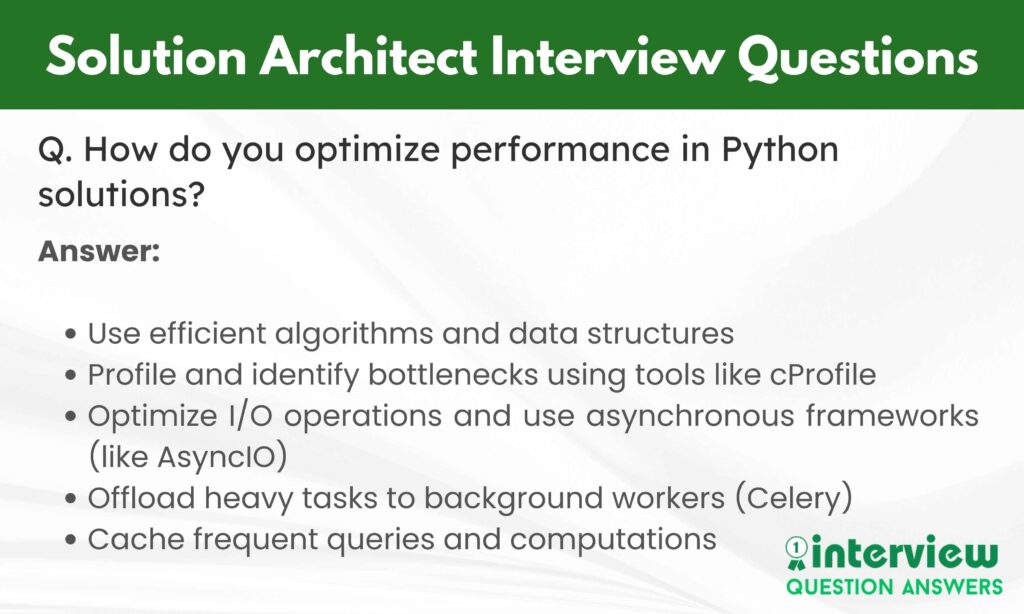
Also Check: Python Interview Questions and Answers
C# Solution Architect Interview Questions and Answers
Que 91. What is the role of a C# Solution Architect?
Answer:
A C# Solution Architect designs enterprise-grade software solutions using the .NET ecosystem. They define system architecture, choose frameworks, manage security, ensure scalability, and lead development teams to build efficient C#-based applications that meet business needs.
Que 92. Which frameworks are commonly used in C# architectures?
Answer:
- ASP.NET Core for web APIs and web apps
- Entity Framework Core for ORM and database management
- Blazor for client-side web development
- SignalR for real-time communication
- NLog or Serilog for logging
- Azure SDKs for cloud integration
Que 93. How do you ensure scalability in C# applications?
Answer:
- Use microservices or modular monoliths with ASP.NET Core
- Implement load balancing and auto-scaling in Azure or AWS
- Optimize database access using Entity Framework caching and connection pooling
- Use asynchronous programming with
async/await - Deploy using Docker and Kubernetes for distributed scaling
Que 94. How is exception handling managed in .NET Core applications?
Answer:
- Use middleware for centralized exception handling
- Create custom exception types for clear error management
- Use structured logging frameworks like Serilog for tracking errors
- Return consistent API error responses using problem details standards
Que 95. What are essential security practices in C# application architecture?
Answer:
- Secure authentication using OAuth2, OpenID Connect, or IdentityServer
- Sanitize inputs to prevent SQL injection and XSS
- Use HTTPS and certificate pinning
- Implement role-based access control (RBAC)
- Encrypt sensitive data both at rest and in transit
Que 96. How do you manage dependencies in large C# projects?
Answer:
- Use NuGet for managing third-party packages
- Apply Dependency Injection (DI) using built-in ASP.NET Core container
- Separate concerns using layered architecture (Controller-Service-Repository pattern)
- Regularly update dependencies and monitor for security vulnerabilities
Que 97. How do you optimize performance in C#/.NET Core applications?
Answer:
- Minimize synchronous code and use
async/awaiteffectively - Profile with tools like Visual Studio Diagnostic Tools or JetBrains dotTrace
- Cache frequently used data using in-memory caching or distributed cache (Redis)
- Optimize Entity Framework queries and database indexing
- Use compression (like Gzip) to reduce response sizes
Que 98. How do you design a scalable C# microservices architecture using .NET Core?
Answer:
Design microservices with .NET Core using ASP.NET Core for APIs, deploying on Kubernetes for orchestration and auto-scaling. Implement service discovery with Consul or Azure Service Fabric, use RabbitMQ for event-driven communication, and store data in SQL Server or Cosmos DB. Ensure resilience with Polly for retries and circuit breakers, monitoring with Application Insights for performance tracking.
Que 99. How do you secure a C# application handling sensitive data in a cloud environment?
Answer:
Secure C# applications with ASP.NET Core Identity for authentication and JWT/OAuth for API access. Use Azure Key Vault for secrets management, enforce HTTPS with TLS, and implement input validation with data annotations. Apply role-based access control, monitor with Microsoft Defender for Cloud, and log activities to Azure Monitor for audit trails.
Que 100. How do you optimize performance in a high-throughput C# application?
Answer:
Optimize by using async/await for I/O-bound operations, leveraging System.Threading.Tasks for parallelism. Cache data with Redis or MemoryCache, profile with BenchmarkDotNet to identify bottlenecks, and optimize database queries with Entity Framework Core. Scale horizontally with Azure App Service or AKS, monitoring performance with Application Insights.
Also Check: C# Interview Questions and Answers
Solution Architect Interview Questions PDF
We have added all Solution Architect interview questions and answers in a PDF file. You can access or download it by using the link below.
FAQs: Solution Architect Interview Questions
What does a Solution Architect do?
A Solution Architect designs technical blueprints for complex software systems, bridging business requirements with technical implementation. They select appropriate technologies, define system architecture, ensure scalability and security, and guide development teams throughout project execution.
What are the main challenges faced by Solution Architects in their daily work?
Key challenges include balancing technical constraints with business budgets, staying current with rapidly evolving technologies, integrating legacy systems with modern solutions, managing stakeholder expectations, and making critical architectural decisions under tight deadlines while ensuring system performance and scalability.
What should I expect during a Solution Architect interview process?
Expect multiple interview rounds including system design problems, technical assessments, architectural scenarios, and behavioral questions. You’ll likely draw system diagrams, explain trade-offs between solutions, discuss cloud services, demonstrate scalability knowledge, and present past project experiences.
What is the average salary for Solution Architects in the USA?
Solution Architect salaries range from $120,000 to $200,000+ annually. Entry-level positions start around $100,000-$130,000, while senior architects earn $180,000-$250,000+. Tech hubs like San Francisco and Seattle offer higher compensation with additional stock options and bonuses.
Which top companies actively hire Solution Architects?
Essential skills include cloud platforms (AWS, Azure, Google Cloud), system design patterns, programming languages, database technologies, and security practices. Strong communication and leadership abilities are crucial. Most roles require a computer science degree, relevant certifications, and 5-10 years of development experience.
How can I best prepare for a Solution Architect interview?
Practice system design problems, review cloud services and architectural patterns, prepare real project examples, and stay updated with industry trends. Create a portfolio of architectural diagrams, practice explaining technical concepts simply, and research the company’s technology stack and challenges.
Conclusion
This guide covers essential Solution Architect interview questions and answers, including architecture concepts, cloud services, security, scalability, and problem-solving approaches. The content helps both junior and senior candidates prepare for interviews across AWS, Azure, and enterprise technologies like Java, Python, and C#.
Use the PDF download to practice offline. These questions will strengthen your understanding and boost confidence for your next Solution Architect interview. Good luck for your next interview.


